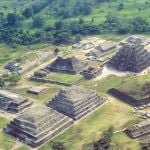
Shortly after the abandonment of Teotihuacan, cities began developing in northern Vera Cruz. The location of Teotihuacan had become quite arid as today, while Vera Cruz benefited from have a lower altitude and proximity to the Gulf of Mexico. The descendants of the builders of these cities called themselves the Totonacs and they claim to have also once been the elite of Teotihuacan. The architecture of these cities, the best known being El Tajin and Cempoala, shared some decorative details with Teotihuacan, but architectural forms and city plans were quite different. The Totonacs learned how to make pozzolanic concrete. This is a fact little known outside of Mexico. Both the walls and floors of temples and homes of the elite were constructed of cast concrete. The plans of Totonac cities were asymmetrical, whereas Teotihuacan was rigidly framed to a long linear plaza or boulevard.
The port of Cempoala, near where the city of Vera Cruz is now located, put the Totonacs in close maritime contact with the Chontal Maya traders in southern Vera Cruz and Tabasco. This is an important fact in understanding how so many Totonac words or words similar to Totonac, could today be in Itza Maya and the Creek languages of the Southeastern United States. The other part of the equation is that the Itza Mayas were forced out of their mountainous homeland by the volcanoes and drought. Itza refugees spread northwestward into Vera Cruzand, northward into Yucatan.
Tamaulipas

Totonac civilization was spread northward along the Gulf Coast by the hybrid Totonac-Chontal Maya traders, who were called Tamahi-te (Trade People) by the Totonacs, Tamau-te by the Itza Maya, Tamaule by the indigenous people of the northern Gulf Coast of Mexico, Tamaltli by the Nahuatl speakers or Tamacoa by Arawak speakers. All five names for merchants can be found in Georgia or southwestern Virginia during the 1500s and 1600s as names of ethnic groups. The Spanish wrote down Tamacoa as Timucua. The name of the province in the coastal plain of Tamaulipas was Am Ixchel, which means “Place of the Goddess Ixchel” in Itza and Chontal Maya.
The Chontal Mayas soon established a trading base at Tampico Bay on the northeast Gulf Coast of Mexico. This grew into a province known as Tamaulipas, which in Itza Maya means “Place of the Tamauli.” The name Tampico is today typically explained as meaning “Place of the Otters” in the Huastec language. However, a more probable explanation is that the word was originally, Tama-pico, meaning “Place of Trade.”
